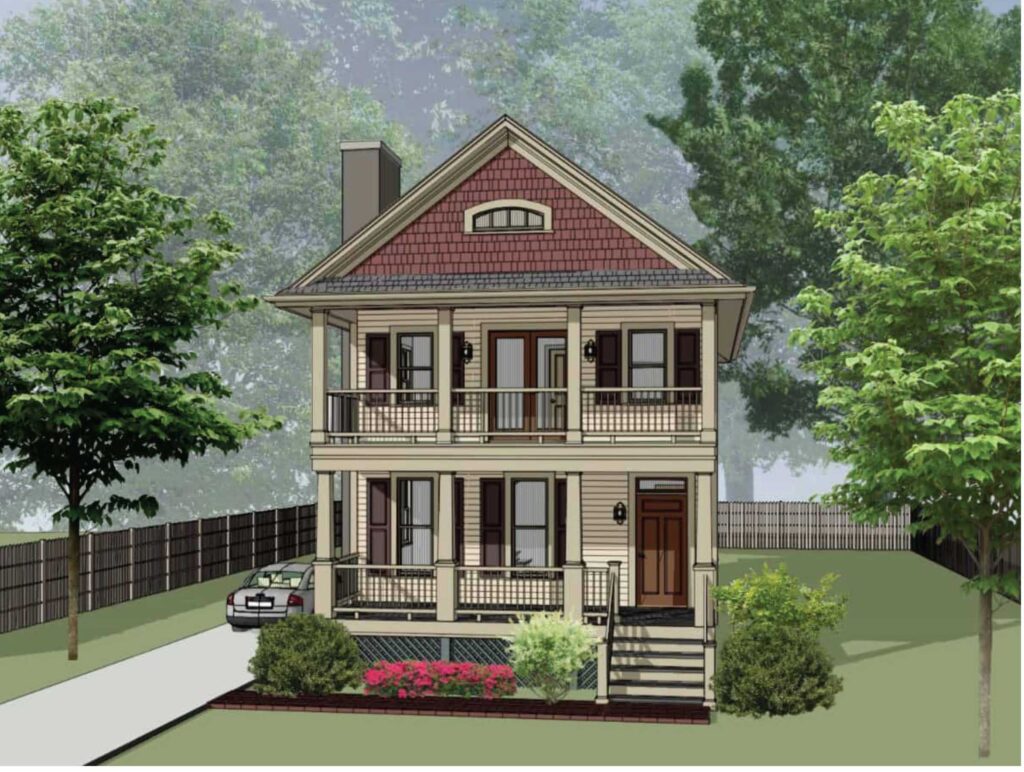What can I say about real estate in Asheville? It seems a bit crazy for an ol-timer like me. When I moved to Sandy Mush in 1981, you could buy an acre out there for $1,000. Now it costs $30,000 per acre. A year later, we moved into a rental home in Montford with 5 bedrooms, 3 full baths, and 2 large living rooms with a fireplace in each one. The owner offered it to us for $30,000 (yes, you read that right). Clearly, times have changed.
I’ve been confronted with this reality lately as I attempt to provide healthy housing at a reasonable cost. We started this 4-acre, 18-home subdivision in 2017, and we sold the first home at the end of 2018. For the next home, I chose a plan from Rick Thompson, with double-decker porches looking at the stunning eastern view. It is 1584 square feet with 3 bedrooms and 2.5 baths on a poured-concrete and frame-walled basement. Therein lies the rub. Originally, I had planned to only rough in under-slab plumbing in the unfinished basement, sizing for the expansion of the high-efficiency heat pump HVAC system, with a sale price around $490,000. My HERS rater, Matt Vande, informed me that it’s tough to leave unfinished space without losing points toward Green Built/Energy Star 3.1. Therefore, I decided to finish a 1-bedroom apartment in the daylight basement, which brings the heated square footage to about 2200.
Selling this GB/ES home for at least $315/s.f. yields a sale price of $693,000, quite pricey for the Oakley neighborhood. In fact, my lender from ALFIE loans felt that my proposed sale price of $690,000 was too high. However, their own official appraisal came in at $695,000! Quite honestly, this makes me uncomfortable. Who are these new buyers of these former middle-class homes, now approaching jumbo mortgages? They’re probably not Asheville’s service workers, teachers, law enforcement, artists, social workers, tradespeople, factory workers, or even many health care workers, unless they’ve been extremely frugal super-savers or have some family money. We set out to build homes for them, but have found ourselves in a very different real estate market. People are struggling to find any decent housing for $350,000.
I think I can fit some more affordable, smaller housing into this development. In last year’s Green Building Directory, I detailed the difficulty in building affordable housing to sell. I concluded: “Currently the American Dream of home ownership is simply not attainable for many folks.” We regret that in a wealthy nation like ours, it is still challenging to buy a home, even while almost 66% of households in the U.S. own their own homes. It is the most common way to accrue wealth, as real estate is a superior investment. In fact, the buyers of the first home we sold in December 2018 sold it again a year and a half later for a whopping $35,000 more than they paid for it!
Despite our concerns about affordability, of course we want to make money, and in fact, this development will help us secure a more comfortable retirement. I’ll be 70 (gulp!) this year, so I’ll have to start building multiple homes at once in order to finish in a timely fashion (read: before I die). We are eternally grateful that Asheville’s real estate market appears so solid, despite the dramatic rise in interest rates. It seems that everyone wants to move here. We support density within the City of Asheville, but outside the city limits, we’re still seeing expensive homesteading land and sprawling, gated communities out in the county. Our new subdivision is not among them. The lots are narrow, but still about .2 acres, and we expect neighborly interactions among the 18 households. They will enjoy a cool, quiet common area with a small pond and a stream flowing through it.
Maybe new home prices in Asheville will stabilize; maybe the market will cool a bit. My heart goes out to the many folks struggling to find a home they can afford to buy here. It’s a double-edged sword—we will profit in this hot housing market yet many folks cannot even afford to rent in town, much less purchase a home. Such is the duality of living under, as author Naomi Klein calls it, “casino capitalism.”
Over my 50-year career in construction, I have worked on everything from small jobs to major additions, expensive kitchen remodels to essential bathroom repairs. I am humbled by the various work crews that have built this new home so far, and the many tradespeople to come who will finish it. I love to create shelter for folks, and I’m glad to be making enough to pay the workers well. Although I am in the construction business, which admittedly contributes to global warming in a big way, I have always liked working with my hands and building things. While I no longer wear a tool belt on site every day — as I did up until 2016 — I know, understand, and like the trades. I respect the precision and the problem-solving we must reckon with, and it’s thrilling to create something from nothing, to watch a house rising from a once overgrown pasture.
Building science has exploded since my carpentry apprenticeship in 1972, especially in terms of sustainability. Despite rising costs, this is a good time and place to build new homes, and I’m optimistic about the industry’s future in Asheville.
Stuart is a husband and father, as well as a rescue dog guardian (Who rescued whom?), who walks in the woods every day, thus remaining relatively sane. He is a licensed general contractor, impassioned by affordable, green housing, and lives in Asheville, North Carolina. He is a minimalist in most regards.


